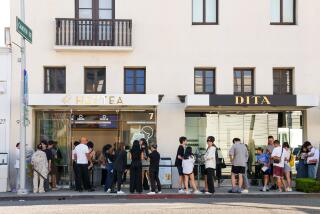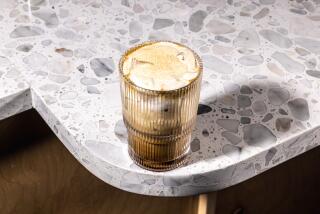Asian Starbucks: Steaming Hot
- Share via
TOKYO — A customer must be lucky to get a seat. Those who can’t--and there are droves--spill onto the sidewalk, sipping lattes or chatting on cell phones as aproned employees push paper cups of coffee across the counter.
Welcome to the world’s busiest Starbucks. It’s not in Seattle, San Francisco or New York. It’s smack in the middle of Tokyo.
The American coffee chain is finding that Asia is a vast, thirsty and untapped market. From Beijing to Bangkok, it is converting tea-lovers into fans of Frappuccino and other frothy coffee drinks.
Just four years after opening its first overseas shop in Tokyo, Starbucks now has more than 250 stores in 10 Asian countries and is planning to more than double that by 2003. Coming soon is its first Asian coffee roasting plant, possibly in the Philippines, Hong Kong or Japan.
The Seattle-based company won’t release sales figures, but there is little room to doubt its popularity throughout the region, where its shops are generally crowded with young white-collar workers and trendy teens.
“We knew our coffee would do well here, but we had no idea it would take off so fast,” said Kazuko Nakada, a spokeswoman for Starbucks Japan.
Starbucks’ success in Asia has indeed been a surprise, since coffee has traditionally been overshadowed in the region by tea.
Perhaps more than taste, it is image that Starbucks has capitalized on.
The Starbucks brand carries a cachet of wealth, success and status in less-developed Asian countries. While no big expense for the average Singaporean or South Korean, sipping a cup of Starbucks coffee is still a strictly urban and upper-class experience in Thailand, the Philippines and Malaysia.
As Asia emerges from economic downturn, a growing middle class is willing to shell out for a cup of coffee that costs more than the average bowl of noodles, even three bowls in some places.
Philippines Starbucks are packed with cell phone-toting young people, their hair dyed an array of blonds and burgundies. In Singapore, executives sit side-by-side with leather-clad rockers. In Taiwan, parents make trips to Starbucks a family outing.
“I never liked coffee before, but it tastes really good here,” said Tokyo resident Mami Taneda, 22, praising both the frothy, flavored coffee and the Starbucks atmosphere. “This isn’t Japan--it’s America.”
Deliberately so.
The chain’s chic interiors and sturdy wooden tables--the decor is nearly identical to that of the U.S. version--are a sharp contrast to Tokyo’s cramped, smoky cafes or Southeast Asia’s tea stalls, where customers sit on plastic stools at wobbly tables.
Taste does matter, however.
Customers say Starbucks drinks taste better than the local coffees that have defined the Asian experience until now: the inky, bitter fluid sweetened with condensed milk and served in plastic bags in Singapore; the instant coffee people drink at home in Beijing and Hong Kong.
“They spend five minutes stirring Nescafe into hot water, and that’s coffee,” said Thomas Neir, owner of a Hong Kong coffee chain that competes with Starbucks. “Very few people even know that it came from a bean.”
Japan is something of an exception.
There is a deeply embedded coffee culture in this country, which is one of the world’s top coffee consumers. Canned-coffee vending machines are everywhere, and people flock to tiny cafes for coffee breaks while smoking or reading.
Still, Starbucks’ success has been remarkable. It has 125 shops in Japan, including the world’s busiest in Tokyo’s trendy Shibuya shopping district.
Market analysts say there has been a dearth of places serving inexpensive coffee in an upscale atmosphere. A cup of coffee on the cheap is often served no-frills, cafeteria style, while a more elegant coffee break can cost upward of 1,000 yen, or about $9.
“The company has done a good job of meeting the demand for a fashionable cafe experience without the expense,” said Kiyoko Muraoka of Next, a Japanese market survey company.
Inevitably, imitations are springing up. Doutor, a Japanese chain, has opened a fancier version of its no-frills cafe, with a logo similar to Starbucks and boasting “real Italian espresso.”
Nakada, the Starbucks Japan spokesman, said the company isn’t worried by imitators and is happy for a growing pool of espresso fans.
Some, however, wonder if Starbucks’ very success could prove a problem.
“If you go to a Starbucks in a busy part of town, you can’t get in,” Muraoka said. “That’s going to drive customers away. No one wants to line up like that just for coffee.”
More to Read
Eat your way across L.A.
Get our weekly Tasting Notes newsletter for reviews, news and more.
You may occasionally receive promotional content from the Los Angeles Times.









